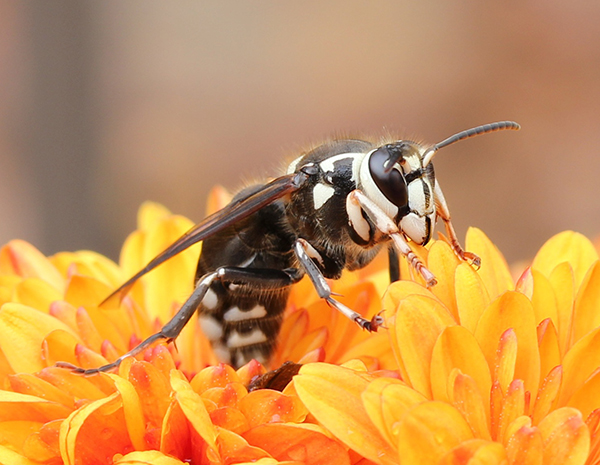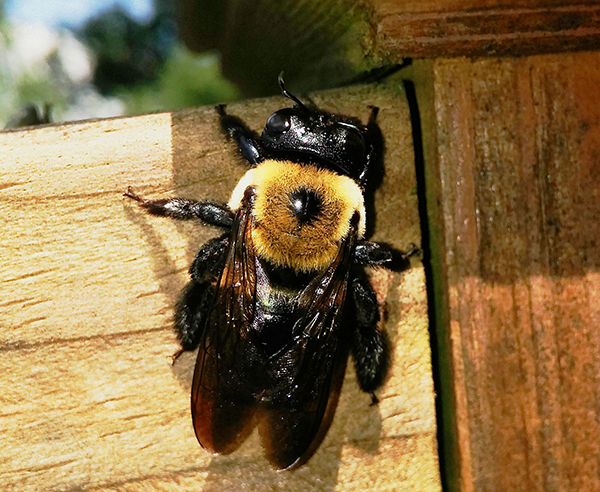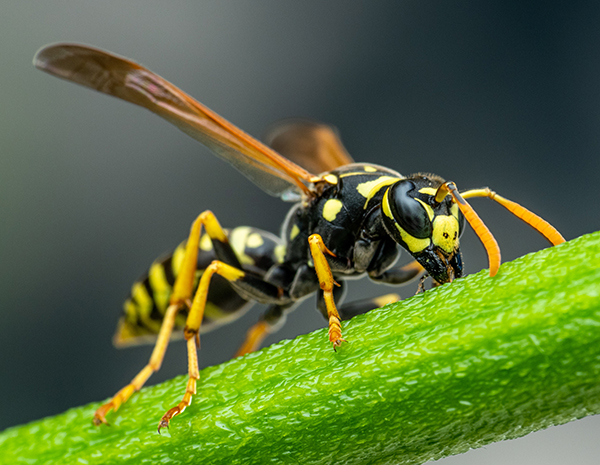Stinging insects like bees, wasps, or Yellowjackets send thousands of people to the emergency room every year. Though most people are not allergic to insect stings, the reaction can range. You could see a mild irritation or a severe allergic reaction. Bees and wasps nests are a common occurrence during the summer months and can be a nuisance if not properly managed. If you find that your property has been invaded by a colony of stinging insects it is in your best interest to contact a pest control specialist.
They are most active in May (first peak season) and August. (second peak season), Common nesting spots include soffits, under and behind gutters, roof peaks, deck railings, behind utility boxes, window/door frames, and small voided areas.
Bee and wasp removal can be very dangerous and should only be done by a professional.
How to Prevent Being Stung by a Bees & Wasps
1. Limit Sweet Beverages While Outdoors – Bees are attracted to the sugar in sweet beverages so inspect cans and straws before drinking out of them.
2. Be Mindful When Mowing – Mowing or trimming the lawn may disturb beehive or wasps nests.
3. Remove Nests & Hives – If you are unable to manage a bee colony, call in the professionals to have the nest or hive removed.
Carpenter Bees
Carpenter Bees look similar to a bumblebee but are larger, faster, and nest inside wood surfaces. They are very noisy and intimidating. The species will rarely sting but will do substantial damage to wood surfaces by boring out perfectly round 3/4 inch hole and then creating horizontal tunnels within the wood to lay eggs and nest.
We treat the individual holes for elimination and treat the rest of the wood surfaces vulnerable to nesting with a repellent to prevent future nesting. Structures such as gazebo’s, gondola’s, sheds, and decks are susceptible to carpenter bee’s as well. Carpenter holes also attract woodpeckers, creating additional damage to the wood.
Hornets
In the family of Wasps, Hornets are the most aggressive stinging insects. They will attack when provoked, threatened, or for no reason at all. Removing a nest yourself can be a tricky, dangerous task. Nesting begins in mid-July and are active until November. Hornets build a paper ball nest ranging in size from 6 inches to 30″ round. Hornets can construct a nest the size of basketball within 7-10 days. Trees, roof peaks, deck overhangs, and corner soffits are all common nest locations. wasp removal service, we will eliminate the nest and remove it from the house or tree.
Yellowjackets
NOTE: Yellowjackets should only be dealt with by a professional.
A Yellowjacket nest can be detected by observing high activity going in and out of an opening throughout the day. (sunrise till dusk)
Yellowjackets are very aggressive stinging insects when they are provoked or threatened. They also can sting multiple times. Loud vibrations or noises will provoke a Yellowjacket as will disturbing their nest.
Yellowjackets are void-nesters. They will either nest in void spaces (wall voids, voids between floors of homes, soffits, crawl space voids) or in the ground. If you see an opening on the house – DO NOT SEAL IT OR SPRAY OVER-THE-COUNTER PESTICIDE into the opening, this will force them to back up into your home or business.
Bald-Faced Hornet
Bald-faced hornets not aggressive unless their is a territorial threat to the hive. If you study an active bald-faced hornet hive, you will see that there are workers that guard the entrance. If you stare at the entrance hole there will be at least one worker that is staring right back.
A bald-faced hornet nest is a beautiful work of art, worthy of protection. Like other members of the yellowjacket family, they build paper nests. Cellulose is chewed into a paste, similar to paper mache. When examined closely, the wood fibers are marbled with different colors. This is due to the different kinds of wood that they marble together into a single sheet of paper that are blanketed together around layers of comb.
Their nests can become a pest control issue if the pear shaped, paper nest are in line with human traffic. Most other nests can be left alone. Bald faced hornet nests can be described as basketballs hanging from trees. They can be anywhere from 3 feet to 60 feet high in trees.
Homeowners are often amazed in fall when the leaves fall off the trees. Baldfaced hornet nests are revealed at head level in ornamental trees. The homeowner wonders how they cut the grass all that time without getting stung.
Paper Wasps
Paper wasps are generally less aggressive than Yellowjackets. During springtime, you’ll frequently notice them emerging from hibernation in attic spaces. Our office receives a number of stinging insect control calls when paper wasps start to swarm about rooftops. After their post-hibernation celebration, native paper wasps usually blend back into nature. You may never see a native paper wasp up close unless you find yourself in a meadow.
The paper wasp gives other paper wasp species a bad wrap. They are much more aggressive than other species. paper wasps have black and yellow coloration and look a lot like Yellowjackets. Paper wasps, however, have longer legs. These pests build open comb nests in fences, sign posts, exterior light fixtures, playground equipment, and window frames.
Paper wasp often build their nests in easily-accessible areas, making them a cinch to remove. During the spring, we dust higher elevations to stop their rooftop swarms.
Mud Daubers
Mud daubers are prolific stinging pests in Midwest. While they don’t usually sting humans, they’re often considered pests due to their activity in and around the home. Lots of people see them buzzing around in high numbers, but are unsure where the nest is. There are three kinds of mud daubers in Midwest: the yellow-and-black mud dauber, the organ pipe mud dauber, and the blue mud dauber. All are solitary stinging insects.
These mission-oriented predators go around collecting spiders and mud. They use their stingers to paralyze the spiders and entomb them in a mud gallery, along with one of their eggs. Once the egg hatches, the larva feeds on the living, yet still-paralyzed spider. After dinner, the mud dauber larva pupates within the mud nest. Finally, it emerges as an adult mud dauber.
Homes are great spots to build mud nests. If you have evergreen bushes with lots of spiders, and an irrigation system, mud daubers will love your house. They are most troublesome when located in window frames or in soffits. Emerging adults often venture inside instead of out.
Mud nests can easily be removed with a scraper tool. We work with the customer to implement cultural controls. You can eliminate these pests from your area by applying mulch to exposed soil and cutting back on irrigation. Just like paper wasps, mud daubers are most active around the roofs of homes. To stop heavy mud dauber activity, we use extension bee poles to dust any crevice showing activity.
Carpenter Bees
Carpenter bees are important pollinators. Nonetheless, they can also be very destructive to a home. They bore into porch ceilings, cedar siding, arbors, and trim — basically anywhere with a shoddy paint job. If you have carpenter bees, it probably means you need to paint or stain certain parts of your home. You can deter carpenter bees from nesting by covering any exposed wood with a thick coat of paint. The bees simply cannot chew their way through a well-painted wood surface. Porch ceilings are prime nesting spots because they are often stained instead of painted. They also find places that are not painted at all, like the underside of porch railings. People with cedar trim or cedar shake get hit with carpenter bees the worst. To add insult to injury, the real damage comes when woodpeckers retrieve the larvae from inside the wood.
Long-term carpenter bee control entails treating the effected wood with fresh paint or stain. Because carpenter bees are pollinators, removing certain flowering plants may also be a valid option. Our treatment involves dusting or foaming galleries. Because caulk is difficult for them to chew through, caulking is a great way to fill in any damage from nesting activities, and can prevent future nests. It’s best to leave the treated holes exposed for a few days before you caulk, though. That way, any bee that was not in the nest during treatment will have a chance to come into contact with the applied product. If entry points are sealed prematurely, carpenter bees might return to the site and cause further damage.
Call us today to learn more! 773-789-9789




